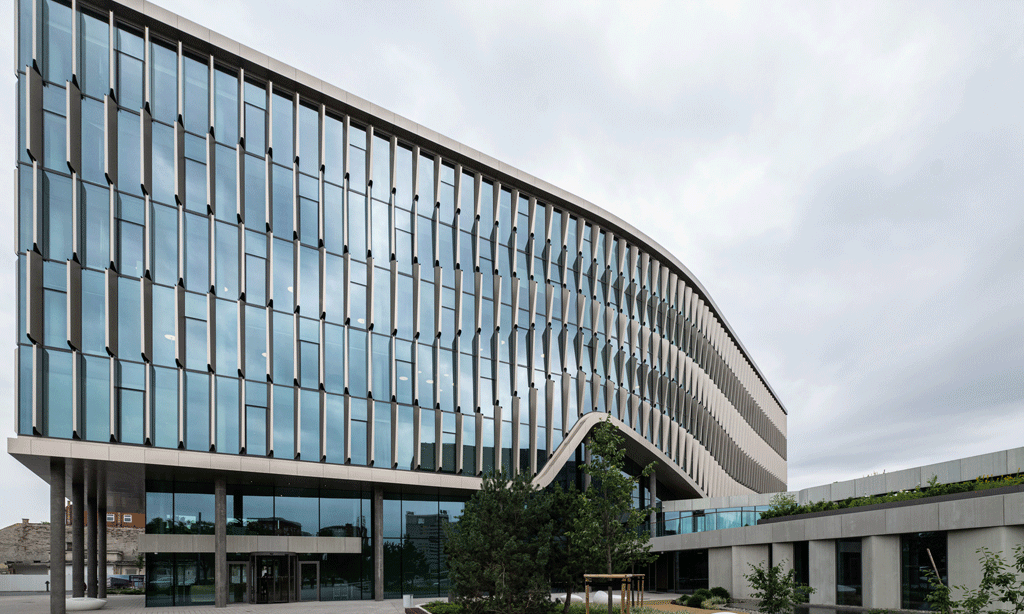New headquarters of Richter Gedeon Plc
Sustainability, energy efficiency and innovation in building automation
The new headquarters of Richter Gedeon Plc is a model of sustainability, energy efficiency and innovation. The building meets the stringent requirements of the internationally recognized LEED Gold certification, which requires a reduced ecological footprint and state-of-the-art technology. LEED Gold certification is an internationally recognised system that assesses the environmental and sustainable performance of buildings. These energy-saving systems significantly reduce operating costs and environmental impact, while the building's restrained design and thoughtful interior layout reflect the company's philosophy. The design has been carefully considered with a focus on staff comfort, so the building's strong, undulating dynamic embodies both modern innovation and harmony.
Elektro-Kamleithner Ltd. has made a significant contribution to achieving sustainability goals with its building automation solutions. Intelligent building automation helps to minimise energy consumption, optimising lighting, heating, cooling and ventilation systems, thereby maximising energy efficiency and reducing the ecological footprint of the building.
Building automation solutions
The design and implementation of the building automation system faced a number of unique challenges. In the case of the Richter headquarters, one of the biggest challenges was to create an integrated system capable of ensuring the coordinated operation of various subsystems such as lighting, shading, heating and cooling and ventilation.
Around 2 500 devices on six floors of the building ensure energy efficiency through the building automation system of Elektro-Kamleithner Kft. In addition to natural diffused light, energy-saving lighting systems have been installed throughout the building, and office lighting is controlled by a set LUX (luminous intensity).
One of the most important devices we have integrated is a special presence sensor that performs several functions at the same time. This sensor is capable of measuring CO2 levels, humidity, brightness, temperature and presence. The resulting data is essential for optimising cooling and heating systems, adjusting variable air volume (VAV) controllers, and controlling the supply and exhaust air. In addition, this sensor provides constant brightness control, which is particularly important for energy saving.
To maximise comfort, cooling-heating ceilings ensure the right temperature, avoiding the distractions of traditional air conditioning. A GPS weather station with sun tracking ensures that the sun does not overheat the offices.
Systems integration and communication technologies
Integrating the complex building automation system with the rest of the building's infrastructure was also key. A fire alarm system was installed in the building, which, when a fire alarm is given, causes the shutters on the escape route's windows and other view ports to be raised to ensure access to and from the building through the glass portal.
The heating, cooling, ventilation and lighting are integrated, all using the KNX building automation system. The audiovisual (AV) system in the building has also been linked to the building automation system. This allows meeting room lighting, shading and other functions to be easily controlled, enhancing user experience and efficiency. This type of integration requires sophisticated communication technologies, which are provided by KNX.
The role of NetX visualisation software and smart control panels
NetX visualisation software and smart control panels were used in the headquarters of Richter Gedeon Nyrt. to accurately control the temperature in large offices and meeting rooms. These devices allow users to intuitively control room temperature, lighting and shading, increasing comfort and efficiency. The visualisation software interface is easy to understand and allows real-time monitoring and control of systems, which is particularly useful for larger, complex buildings.
KNX building automation: the technology of the future
The KNX building automation system is the pinnacle of intelligent solutions for modern buildings, allowing the integration and optimisation of different building systems. The most important features and benefits of the system are described below.
Manufacturer independence and compatibility
One of the most important advantages of the KNX system is its manufacturer independence, which ensures that devices from different manufacturers integrated into the system are fully compatible with each other. Devices with the KNX logo work together seamlessly, regardless of the manufacturer. This openness allows us to offer a wide range of building automation solutions to meet different needs and requirements.
Decentralised structure and flexibility
The decentralised structure of the KNX system allows the different functions to work independently but in harmony. This modular design gives users extreme flexibility, as the system can be easily extended and the whole system does not need to be rebuilt when new functions are added. The use of industrial-grade components further increases operational stability and durability, ensuring long-term reliability.
Energy efficiency and sustainability
The KNX system has outstanding energy efficiency properties, allowing precise control of lighting, heating, cooling and other building services systems. Compliance with the MSZ EN 52120-1 standard guarantees that the system improves the energy performance of buildings, thereby reducing the environmental impact and operating costs.
Future-proofing and technological progress
KNX offers future-proof technology that is constantly adapting to the latest innovations. This flexibility allows the system to be expanded and upgraded as technology evolves, without the need for a complete system replacement. This is particularly important in a dynamically changing industry such as building automation, where innovation and sustainability are key factors.
Maintenance and support
Building automation system maintenance is essential to ensure long-term reliability. The recommended maintenance cycle is every six months, which includes checking the bus network, testing devices and sensors, and reviewing the condition of the mechanical equipment. Although the system does not require software upgrades, regular checks ensure that building automation solutions are always delivering the highest level of efficiency.
Environmental awareness and long-term reliability
The new headquarters of Richter Gedeon Plc is a modern building that not only reflects the company's philosophy, but also incorporates forward-looking technological solutions. By using a building automation system, especially KNX, the office is not only environmentally friendly and energy efficient, but also economical to run in the long term. This approach reflects the company's commitment to sustainability and social responsibility, while combining the latest innovations with reliable operations.

